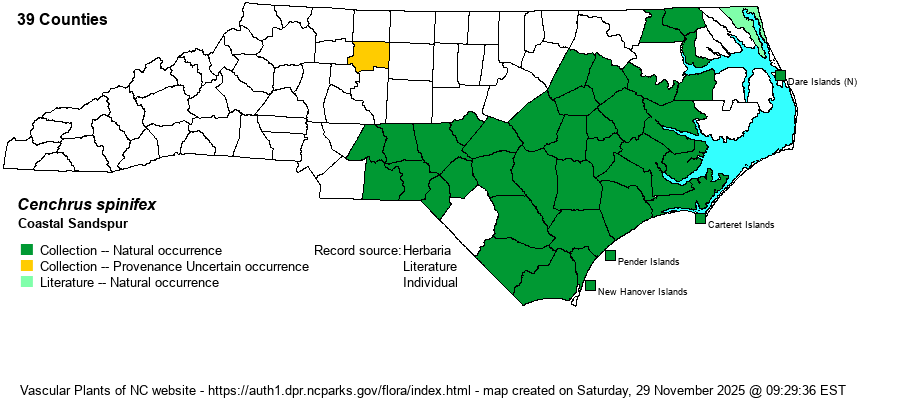| Author | Cavanilles | |
| Distribution | Formerly named as C. incertus. Coastal Plain, Sandhills, and lower Piedmont; disjunct to Forsyth County. Range maps in RAB (1968), BONAP, and some other sources seem to have this species confused with C. longispinus and it may be that the maps in RAB are reversed. Based on specimens, C. spinifex seems to be common across nearly all of the Coastal Plain and southeastern Piedmont; on the other hand, C. longispinus is more spottily collected across the Coastal Plain and Piedmont.
VA to KS and CA south to southern FL, southern TX, Mex., C.A., S.A. | |
| Abundance | Frequent to common nearly throughout the Coastal Plain and southeastern edge of the Piedmont. Not numerous in the northern and northeastern Coastal Plain. The website editors suggest a State Rank of S5? -- the "?" added owing to the uncertainty of specimen identification between this species and C. longispinus. | |
| Habitat | Dry sandy soil of roadsides, powerline clearings, fields, woodland edges, disturbed sites. | |
| Phenology | Flowering and fruiting July-October. | |
| Identification | This native species can be told from the rare native C. echinatus by having multiple whorls of stout spines (vs. a single whorl in that species). From the common native C. tribuloides it differs in its shorter burs (not including spines, 5.5-12 mm long vs. 9-16 mm long in that species). From the native C. longispinus it can be separated by having fewer spines (6-10 spines vs. 45-75 spines in that species), and the spines are stouter but shorter (only 2-5 mm long vs. 3.5-7 mm long in that species). | |
| Taxonomic Comments | A synonym is Cenchrus spinifex Cavanilles. In fact, in 2023, Weakley's flora now use this name over C. incertus: "The name C. spinifex has priority over C. incertus, if it applies to this species. Ward (2010b) argued that the name C. spinifex is very uncertainly applied to our species and should not be taken up. Verloove & Sánchez Gullón (2012) disagreed: "the type of the latter name [C. spinifex] and states that it definitely refers to the taxon traditionally called C. incertus" (Weakley 2023).
Sandspurs are notorious for their extremely strong and sharp spines which catch on clothing, fur, and skin alike. The spines actually are flattened and extremely hardened bristles borne at the base of each spikelet. There also is a second set of bristles just outside the spines and not hardened. Care must be taken with a dissecting scope to reach accurate identification. NOTE: Some sites use "sandspur" and some use "sandbur" for the group common name for Cenchrus. In the Carolinas, at least, "sandspur" is much the more often used -- as do Weakley (2018) and RAB (1968) -- and thus the website editors are using that group common name. | |
| Other Common Name(s) | Spiny Sandspur | |
| State Rank | S4 [S5?] | |
| Global Rank | G5 | |
| State Status | | |
| US Status | | |
| USACE-agcp | | |
| USACE-emp | | |

